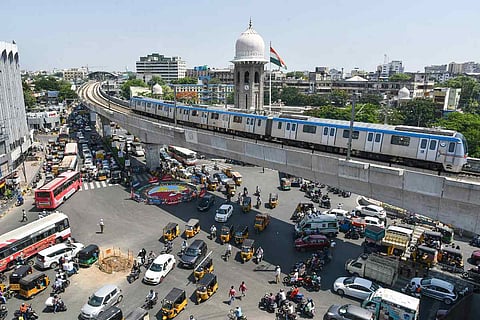

Telangana’s Hyderabad and Andhra Pradesh’s Visakhapatnam have exceeded the permissible limits of both the World Health Organisation (WHO) and the National Ambient Air Quality Standards (NAAQS) in terms of air pollution, according to a study by Greenpeace India. The not-for-profit NGO, fighting global environmental problems, found that particulate matter 2.5 (PM2.5) in both these cities have seen an increase by 7 to 8 times while PM10 has increased nearly 6 to 7 times. The latest findings are part of Greenpeace India’s analysis of the air quality data in 10 southern states, including Bengaluru, Chennai, Kochi, Mangaluru, Mysuru, Puducherry, Coimbatore and Amaravati. The study has revealed that south Indian cities are not too far from cities like Delhi in terms of the health and economic impact of air pollution.
Particulate matter is the total solid and liquid particles suspended in air, often many of which are hazardous. This includes both organic and inorganic particles like dust, pollen, soot, smoke and liquid droplets. Particulate matter is defined by the diameter of the particles, which could be 2.5 microns or smaller (PM2.5) or 10 microns or smaller (PM10). Particles produced by vehicles are generally PM2.5 (fine particulate matter) while dust from construction sites is PM10 (coarse particulate matter). “Both PM2.5 and PM10 are capable of penetrating deep into the lungs, but PM2.5 ₅ can even enter the bloodstream, primarily resulting in cardiovascular and respiratory impacts, and also affecting other organs,” WHO said in its 2021 revised air pollution guidelines.
Despite lockdown and comparatively fewer economic activities, the average values of PM2.5 and PM10 of the south Indian cities it studied exceeded the WHO’s revised standards — 5 μg/m3 (annual mean) and 15 μg/m3 (24-hour mean) for PM2.5, and 15 μg/m3 (annual mean) 45 μg/m3 (24-hour mean) for PM10.
While all 10 south Indian cities far exceed the WHO limit of 5 μg/m3 (annual mean), Visakhapatnam far exceeds NAAQS's annual PM2.5 concentrations of 40 µg/m3, touching nearly 50 µg/m3. Hyderabad exceeds NAAQS limit by a moderate amount. Other cities are well within the NAAQS limit for PM2.5.
“Visakhapatnam and Hyderabad have increased by 7 to 8 times, while Coimbatore, Bengaluru, Amaravati, and Mangaluru have increased by 6 to 7 times, and Chennai, Kochi, Mysuru and Puducherry have increased by 4 to 5 times, which is higher than WHO revised standards and well within the NAAQS standards,” the Greenpeace India report talks about the annual average PM2.5 values of the 10 south Indian cities.
“If we talk about PM10, then Visakhapatnam and Hyderabad have increased by 6 to 7 times, Bengaluru, Mangalore, Amaravati, Chennai and Kochi have increased by 3 to 4 times, Mysuru, Coimbatore and Puducherry have increased by 2 to 3 times higher than WHO revised standards. Apart from that Visakhapatnam and Hyderabad values are 1.5 to 2 times higher than NAAQS prescribed standards and the rest of the cities are within the limits,” it added.
Images from Greenpeace India Report, January 2022
According to an online tool developed by IQAir AirVisual (air pollution app) and Greenpeace Southeast Asia, air pollution is responsible for 11,000 premature deaths in Hyderabad in 2020. Among other south Indian cities, it estimated 12,000 avoidable deaths in Bengaluru and 11,000 deaths in Chennai in 2020.
Hyderabad has six monitoring stations under the Central Pollution Control Board (CPCB) and the Telangana State Pollution Control Board (TSPC). The monitoring stations at Sanathnagar, zoo park, Bollaram industrial park recorded PM2.5 readings above the NAAQS standard while the recording stations at Pashamylaram, ICRISAT Patancheru and the Central University recorded values lower than the NAAQS limit.
Previous studies by the Central Pollution Control Board have revealed that the main contributors to the pollution crisis in Hyderabad are vehicles.
Explaining the reason for Visakhapatnam’s high pollution levels, Avinash Kumar Chanchal, Campaign Manager, Greenpeace India, said, “The annual average of PM10 for Visakhapatnam is 114. Under the national clean air programme, the city needs to achieve the targeted annual average of 51 PM10 by 2024.”
He noted that industrial pollution is one of the major contributors to the air pollution crisis in Visakhapatnam. “Resuspension of road dust, emission from transport, solid waste, use of coal and wood for domestic and commercial cooking activities, etc also contribute to the air pollution crisis in the city,” Avinash added.
Incidentally, WHO’s new guidelines have been deduced from strong scientific evidence of the damage air pollution inflicts on human health. Interestingly, in India, the national ambient air quality standards (NAAQS) for some pollutants are already exceeding the WHO air quality guidelines.
Image from Greenpeace India Report, January 2022
Air pollution is more likely to cause premature death and many medical conditions, including asthma, preterm birth, low birth weight, depression, schizophrenia, diabetes, stroke and lung cancer. Ambient PM2.5 is among the three largest risk factors for deaths in the country.
An estimated 1.1 million deaths per year in India are due to the ambient PM 2.5, Greenpeace India report cites a Lancet paper titled the Global Burden of Diseases Study 2015.
Renewable energy should be the way forward. State governments should promote decentralised renewable energy solutions such as rooftop solar, create integrated public transport, and also address pollution contributors like waste burning, construction sector, industrial emissions and biomass burning.
According to Greenpeace India, taking some actions on priority can help bring a difference in the readings recorded. Seeking alternatives to burning fossil fuels for power, transport and industry would be the first step. If the state governments work on improving transport infrastructure, that, too, can help. Developing green spaces is another important step that can be taken. The government can also achieve a lot by communicating and coordinating with local residents.